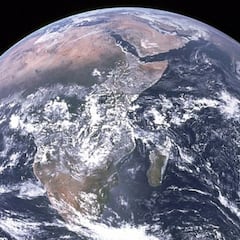What would NASA do if an asteroid were to hit Earth? When is the next asteroid coming?
Around 500 meteorites hit the earth every year but what about the big one? Scientists say we shouldn't worry too much about a Don't Look Up scenario.

Netflix hit Don’t Look Up, starring Leonardo DiCaprio and Jennifer Lawrence, met with some robust debate as to the rigidity of the science deployed in writer-director Adam McKay’s script, but anyone who has seen The Big Short will know the filmmaker is quite capable of slicing to the core of an issue when required. The premise of Don’t Look Up – that the human race would be too busy looking down at their smart phones to believe or perhaps even care that an asteroid was about to wipe the planet from the solar system – also served as an allegory for the threat of climate change, but it has reignited interest in that most existential of questions: when is earth due its big bang moment?
Predicting the end of the world was once the preserve of oracles like Nostradamus, whose quatrains predicting the future are often cited when things have already taken a significant turn for the worse – and placard-wielding doomsayers. The French seer based his predictions on astrological movements and some have posited that his mention of a “celestial stone” falling to earth signifies an event such as an asteroid hitting the earth.
In fact, on average, a meteorite hits the earth every day: according to the Planetary Science Institute (PSI), some 500 impact the earth every year, but are of a size that precludes any significant damage and mostly either fall into the sea or the planet’s vast uninhabited expanses.

Related news:
- NASA's exoplanet count tops 5,000: is there life out there?
- Did a rocket just hit the Moon?
- Which countries have had no coronavirus cases?
- WWF confirm 224 new species of animals and plants discovered
- Earth's sixth mass extinction has begun according to scientists
What has NASA got up its sleeve for an asteroid strike?
Those celestial bodies that are of interest to the PSI and NASA are known as Near Earth Objects (NEOs), which can become Potentially Hazardous Objects (PHOs) if they pass close enough to the planet. However, the US space agency stresses that a “near-earth” object is anything that comes within 0.3 astronomical units, or roughly 45 million kilometres, of the earth’s orbit.
These NEO’s are monitored by NASA’s Center for Near Earth Object Studies at the agency’s Jet Propulsion Laboratory, which deploys the Sentry-II next generation impact monitoring algorithm. What NASA is particularly interested in are NEAs – Near Earth Asteroids – of which some 28,000 have been detected to date.
Again, the bulk of interplanetary material reaching the earth - about one hundred tons daily – is particle sized and completely harmless. According to NASA, about one every 10,000 years an asteroid of 100m or more can be expected to hit the earth, with a larger object of over a kilometre only likely to his every few hundred thousand years.
If something of that size does look like it has designs on a game of celestial snooker, NASA has DART (Double Asteroid Redirection Test), a planetary defence-driven test of technologies for preventing an impact of Earth by a hazardous asteroid. DART, which launched last November, is set to smash into an asteroid known as Dimorphos, basically to see if it can knock it off its current course, in what NASA trusts will be the first demonstration of the kinetic impactor technique to change the motion of an asteroid in space.
Is the end nigh?
https://t.co/jVJPZ05ZRf
— PSI (@planetarysci) November 29, 2021
NASA's DART Spacecraft Launches to Try to Redirect Asteroid
Several PSI scientists are working on the world’s first full-scale mission to test technology for defending Earth against potential asteroid or comet hazards. pic.twitter.com/1wQzJVXaIj
The quick answer is yes, but at some point, as opposed to being nigh… but given the last extinction event triggered by a massive asteroid smashing into the planet was the Cretaceous–Paleogene extinction event of 66 million years ago, it shouldn’t affect anyone’s summer holiday plans.
According to the PSI, the biggest current threat to the earth is the 250m-diameter asteroid 99942 Apophis, which has a one in 250,000 chance of hitting the Earth in 2029 and about one chance in 300,000 of hitting the Earth in 2036. Such an asteroid would make a crater of around two or three km in diameter and would be perfectly capable of taking out an entire city, but would not be threatening to life on a global scale. The asteroid that hit the earth 66 million years ago and wiped out three-quarters of life on the planet was between 10-15km wide.
FACT: There is no known threat from any asteroid for at least the next 100 years.
— NASA (@NASA) January 13, 2022
Our Planetary Defense Coordination Office constantly monitors potential threats from asteroids and other Near-Earth Objects. Follow @AsteroidWatch for updates. https://t.co/2Ym48RH37k
How will the end of world come about?
A city-sized asteroid whacking into the earth is good fodder for Hollywood but the reality is that mankind will in all likelihood have conspired to wipe itself out long before the solar system gets around to it for us.
Related stories
Among the more probably causes the planet will be returned to the beasts are global nuclear warfare, climate change, pandemic threats, the earth's core cooling, overpopulation (or the possibility of dying out due to a massive population drop as a result of deforestation) or, simply, running out of resources to feed nine billion people.
As suggested by Don’t Look Up, perhaps it might be an idea if we started looking to our own planet rather than worrying too much about the slings and arrows of outer space-based misfortune.


